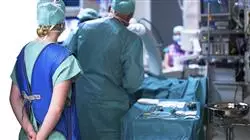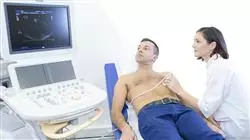University certificate
The world's largest faculty of nursing”
Introduction to the Program
Scientific innovation increasingly drives cardiovascular nurses. In this program, you will have access to the latest developments in Congenital Obstructive Disorders and non-pharmacological treatment"

Cardiology has progressively incorporated new advances in genetics and molecular biology studies. Cardiovascular nurses must continually update their knowledge and techniques to incorporate them into their daily practice.
The contexts in which Cardiovascular Nursing is involved are innumerable, as the factors that specifically concern this specialty include population aging, social, economic and consumer changes, and worsening air quality, among others. Healthcare systems must respond to the increase in clinical cases with an up-to-date perspective, addressing the growing complexities based on the latest scientific postulates.
During the program, healthcare professionals will update their knowledge in the treatment and care of patients diagnosed with the main cardiovascular pathologies, including diseases of the myocardium and pericardium, coronary artery disease and arrhythmias.
The Masters Degree in Cardiovascular Nursing aims to refresh and update the professional’s skills in the field of cardiology. TECH has a teaching team of practicing cardiology specialists, with careers dedicated to specialization and the pursuit of innovative medical techniques, and a commitment to providing nurses with material that combines current theory and its application in practical cases. The entire syllabus is designed in such a way that it can be viewed, studied and practiced, with self-knowledge exercises from anywhere, since the teaching is 100% online.
You will get up to speed on the main acute cardiovascular syndromes, as well as acute coronary syndromes, left and right heart failure, among others"
This Masters Degree in Cardiovascular Nursing contains the most complete and up-to-date scientific program on the market. The most important features include:
- Practical cases presented by experts in Cardiology Nursing
- The graphic, schematic, and practical contents with which they are created, provide scientific and practical information on the disciplines that are essential for professional practice
- Practical exercises where the self-assessment process can be carried out to improve learning
- Its special emphasis on innovative methodologies
- Theoretical lessons, questions to the expert, debate forums on controversial topics, and individual reflection assignments
- Access to content from any fixed or portable device with an Internet connection
You will obtain an up-to-date view on the classification of the different cardiomyopathies from their diagnosis, treatment, evolution and follow-up, differentiating between congenital heart disease and hereditary heart disease"
The program’s teaching staff includes professionals from the sector who contribute their work experience to this program, as well as renowned specialists from leading societies and prestigious universities.
Its multimedia content, developed with the latest educational technology, will allow professionals to learn in a contextual and situated learning environment, i.e., a simulated environment that will provide immersive training programmed to train in real situations.
The design of this program focuses on Problem-Based Learning, by means of which professionals must try to solve the different professional practice situations that are presented to them throughout the academic year. For this purpose, the student will be assisted by an innovative interactive video system created by renowned and experienced experts.
You will analyze the functioning of the Cardiac Rehabilitation Units and the different functions of the professionals in the field of Cardiology”

You will have access to a library of contents created by specialists in Cardiology, with high-quality theoretical and practical content”
Why study at TECH?
TECH is the world’s largest online university. With an impressive catalog of more than 14,000 university programs available in 11 languages, it is positioned as a leader in employability, with a 99% job placement rate. In addition, it relies on an enormous faculty of more than 6,000 professors of the highest international renown.

Study at the world's largest online university and guarantee your professional success. The future starts at TECH”
The world’s best online university according to FORBES
The prestigious Forbes magazine, specialized in business and finance, has highlighted TECH as “the world's best online university” This is what they have recently stated in an article in their digital edition in which they echo the success story of this institution, “thanks to the academic offer it provides, the selection of its teaching staff, and an innovative learning method aimed at educating the professionals of the future”
A revolutionary study method, a cutting-edge faculty and a practical focus: the key to TECH's success.
The most complete study plans on the university scene
TECH offers the most complete study plans on the university scene, with syllabuses that cover fundamental concepts and, at the same time, the main scientific advances in their specific scientific areas. In addition, these programs are continuously being updated to guarantee students the academic vanguard and the most in-demand professional skills. In this way, the university's qualifications provide its graduates with a significant advantage to propel their careers to success.
TECH offers the most comprehensive and intensive study plans on the current university scene.
A world-class teaching staff
TECH's teaching staff is made up of more than 6,000 professors with the highest international recognition. Professors, researchers and top executives of multinational companies, including Isaiah Covington, performance coach of the Boston Celtics; Magda Romanska, principal investigator at Harvard MetaLAB; Ignacio Wistumba, chairman of the department of translational molecular pathology at MD Anderson Cancer Center; and D.W. Pine, creative director of TIME magazine, among others.
Internationally renowned experts, specialized in different branches of Health, Technology, Communication and Business, form part of the TECH faculty.
A unique learning method
TECH is the first university to use Relearning in all its programs. It is the best online learning methodology, accredited with international teaching quality certifications, provided by prestigious educational agencies. In addition, this disruptive educational model is complemented with the “Case Method”, thereby setting up a unique online teaching strategy. Innovative teaching resources are also implemented, including detailed videos, infographics and interactive summaries.
TECH combines Relearning and the Case Method in all its university programs to guarantee excellent theoretical and practical learning, studying whenever and wherever you want.
The world's largest online university
TECH is the world’s largest online university. We are the largest educational institution, with the best and widest online educational catalog, one hundred percent online and covering the vast majority of areas of knowledge. We offer a large selection of our own degrees and accredited online undergraduate and postgraduate degrees. In total, more than 14,000 university degrees, in eleven different languages, make us the largest educational largest in the world.
TECH has the world's most extensive catalog of academic and official programs, available in more than 11 languages.
Google Premier Partner
The American technology giant has awarded TECH the Google Google Premier Partner badge. This award, which is only available to 3% of the world's companies, highlights the efficient, flexible and tailored experience that this university provides to students. The recognition as a Google Premier Partner not only accredits the maximum rigor, performance and investment in TECH's digital infrastructures, but also places this university as one of the world's leading technology companies.
Google has positioned TECH in the top 3% of the world's most important technology companies by awarding it its Google Premier Partner badge.
The official online university of the NBA
TECH is the official online university of the NBA. Thanks to our agreement with the biggest league in basketball, we offer our students exclusive university programs, as well as a wide variety of educational resources focused on the business of the league and other areas of the sports industry. Each program is made up of a uniquely designed syllabus and features exceptional guest hosts: professionals with a distinguished sports background who will offer their expertise on the most relevant topics.
TECH has been selected by the NBA, the world's top basketball league, as its official online university.
The top-rated university by its students
Students have positioned TECH as the world's top-rated university on the main review websites, with a highest rating of 4.9 out of 5, obtained from more than 1,000 reviews. These results consolidate TECH as the benchmark university institution at an international level, reflecting the excellence and positive impact of its educational model.” reflecting the excellence and positive impact of its educational model.”
TECH is the world’s top-rated university by its students.
Leaders in employability
TECH has managed to become the leading university in employability. 99% of its students obtain jobs in the academic field they have studied, within one year of completing any of the university's programs. A similar number achieve immediate career enhancement. All this thanks to a study methodology that bases its effectiveness on the acquisition of practical skills, which are absolutely necessary for professional development.
99% of TECH graduates find a job within a year of completing their studies.
Master's Degree in Nursing in the Cardiology Service
Nursing in the cardiology service is a specialized area of nursing that focuses on providing care for patients with heart disease. Nurses in this service must have specific knowledge and skills in managing patients with diseases of the cardiovascular system.
Nurses specializing in heart disease.
Among the main responsibilities of nurses in the cardiology service may include monitoring patients with heart disease, administering medications, treating and dressing wounds, managing patient safety, assisting in surgical interventions, and providing palliative care. Nurses in the cardiology service may coordinate the patient's plan of care in collaboration with other members of the health care team, such as physicians, physician assistants and therapists.
In addition to these general functions, nurses on the cardiology service may assume more specific roles, such as managing patients who have undergone cardiac catheterizations or surgical interventions, monitoring patients who are on assisted ventilation, or managing patients who require constant heart rate and blood pressure monitors.
Cardiology nurses must also have skills in patient and family education, providing information about their disease and treatment, offer advice and recommendations to prevent the onset of future complications such as physical activity and healthy diet, and offer resources and emotional support to facilitate the patient's recovery. Nursing in the cardiology service focuses on providing specialized care to patients with heart disease. Nurses in this setting have specific responsibilities in patient care and management, and must have skills in patient and family education to ensure an effective and satisfactory recovery.







